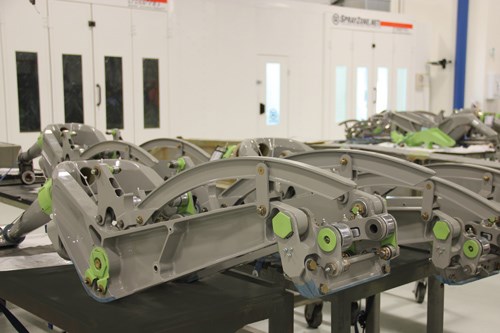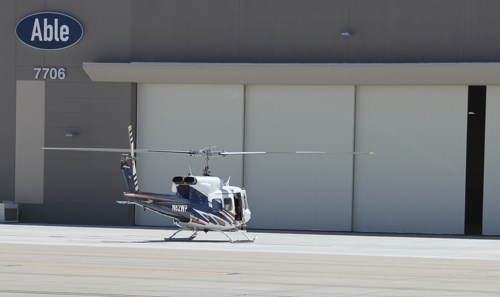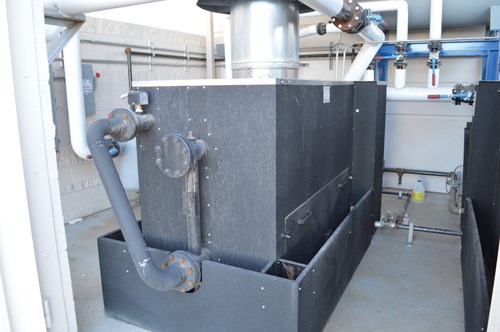Able And Ready For Arizona Plating Facility
Able Engineering’s Arizona plating facility specializes in aerospace repairs. See the video of the facility.
#pollutioncontrol #surfin #masking
Lee Benson’s initial foray into the electroplating industry back in the 1980s was a successful one. He started as a technician on a plating line and soon became supervisor, then general manager and eventually vice president of sales.
His company was plating parts for aerospace firms in the Phoenix, Arizona, area, and things were humming; it surpassed $1 million in sales in 1992, and Benson owned about 25 percent of a business that employed 28 people.
Featured Content
Then one day in 1993, things came crashing to the ground. About 90 percent of the company’s work was with one firm—Garrett AiResearch, makers of turboprop engines and turbochargers—and that relationship ended quickly and hard. Benson’s company essentially lost all its business overnight.
Benson’s boss walked into his office and told him in no uncertain terms: “Close the business, or sell it.”
But with plating now in his blood, Benson did neither. Instead, he brought in partners to buy the company and named his new firm Able Engineering & Component Services.
One Line, Three Employees
With just one plating line and three employees, Benson charted a course for success that included adding services for his aerospace customers, and developing a unique management style and an extremely hard work ethic.
Today, Benson is the CEO, president and majority owner of a $100 million company with 350 employees. It recently moved into a new facility in Mesa, Arizona, that was funded by the city and is located at the end of the runway at Phoenix-Mesa Gateway Airport.
The new location—featuring all-new plating lines, machining areas and fabrication stations—is ideal, enabling helicopters and airplanes to roll right up to the 23,000-square-foot, on-site hangar so that parts can be removed and remanufactured quickly and efficiently.
Formerly a business on its deathbed, Able Engineering is now performing more than 8,000 Federal Aviation Administration-approved repairs for more than 3,600 customers from all over the world.
“We plan to triple the business in five years,” says Benson, who has been praised by everyone from local and state government officials in Arizona to the U.S. Secretary of Commerce to business guru Jack Welch. “This is the beginning of an exciting new chapter in our company’s growth. We’re already the most cost-effective MRO and parts provider for our customers; this new fly-in facility positions us as the most convenient, too.”
Community Support
The new 190,000-square-foot facility that Able moved into in April 2013 came about because of an innovative idea by Mesa officials, who saw their community decimated when Williams Air Force Base closed in the early 1990s. The city converted the land into the public airport and then established a foreign-trade zone to attract businesses to the 2,000-acre site. Bringing Able and its plating and machining lines to Mesa was an important part of the city’s new HEAT program, which stands for healthcare, education, aerospace and tourism/technology.
“Able Engineering is a perfect fit for the Gateway area and represents the aerospace pillar in Mesa’s HEAT initiative for economic development,” says Mesa Mayor Scott Smith. “They will bring hundreds of high-tech jobs into an area that is becoming well-known for aerospace research, design and defense.”
Designing the new plating area inside the facility fell on the shoulders of Yuri Hoverson, Able’s project engineering manager. Hoverson sought out CJI Process Systems in Santa Fe Springs, California, and owners Archie and John Cholakian to help start the design process.
“We started talking with the CJI team in 2006 about our new facility, but then we had some starts and stops because of the economy,” Hoverson says. “Over the last few years, when we finally got the go-ahead, we had the chance to go back and revisit what we spoke about and make some modifications, but it seemed we were always on the same page.”
Numerous Processes
CJI and its team—which has become leading specialists in the fabrication of plating and metal finishing equipment—began by examining Able’s processes, which were made up of numerous certifications and various lines, including:
• Chromium plating per AMS-QQ-C-320, AMS 2406 and BAC 5709
• Nickel plating per MIL-STD-865, AMS-QQ-N-290, AMS 2424 and BAC 5746
• Cadmium plating per MIL-STD-865, AMS-QQ-P-416, BAC 5854 and BAC 5718
• Silver plating per ASTM-B-700 and MIL-STD-865
• Passivation per ASTM-A-967
• Anodizing per AMS-A-8625 and BAC 5019
• Aluminum chemical conversion per AMS-C-5541
• Magnesium chemical conversion per AMS-M-3171.
Moving from a 3,000-square-foot plating operation to 17,000 square feet wasn’t an easy task for the CJI team. Bigger does not always equate to better and more efficient.
“The first item we have to look at is to define the processes that a customer wants and then take a close look at the throughput requirements of each process,” says John Cholakian, CJI vice president. “From there, we can start identifying the major and support equipment that will be needed.”
CJI designs, fabricates and installs its own equipment, which often means a team of experts is working on a project to bring the plan together. That includes company President Archie Cholakian and his son, John, as well as Sales Manager Jerry Coombs, Project Manager Mike Grant, General Manager Eddie Na and Engineering Manager Peter Tombakian, all of whom have a skilled group of craftsmen working under them to get the projects finished.
In-House Capabilities
Hoverson says one of the great benefits of working with CJI is that it has the in-house capability to take a project from the initial concept stages and see it all the way through engineering, permit application, fabrication, installation and, finally, start-up.
“We had some definite ideas on what we wanted the plating shop to look like,” says Hoverson, who has been with Able for 15 years, including running the finishing operations for the first seven of those years. “We also hired on some experienced plating shop managers, so we had some visions even before we brought CJI in to talk with us.”
While too many cooks can often spoil the meal, the synergy between Able’s plating staff and CJI was evident from the start.
“They really listened to us, which was extremely helpful in getting the process moving,” Hoverson says. “John and his team really incorporated our thoughts, but they also brought a fresh set of eyes from all their experience over the years. It was really great working with them in getting this facility built.”
One of the trademarks of the CJI process is that most of the tank lines are constructed in modules in the company’s Santa Fe, New Mexico, facility for easy shipping and installation in Phoenix or anywhere else in the world new lines need to be built.
Improved Efficiency
Although the new Able plating operations’ square-footage increased more than 500 percent, the company didn’t expand its capabilities more than what it had in the previous facility in Phoenix.
“We already had these processes going, but we didn’t have them lined up very efficiently,” Hoverson says. “That was the key in designing the new space, and we are certainly seeing the quality of our lines improve, because we now have dedicated lines and dedicated rinses. Plus we’ll be a zero-discharge facility.”
Also included in the installation was a new hot water system from Parker Boiler. The Los Angeles company installed two of its high-efficiency, direct-fired hot water boilers, which each offer as much as 2.16 million Btu input. The atmospheric burner is about 85-percent efficient.
Hoverson says that his company initially investigated using electric heat but then talked with Michael Leeming from Parker Boilers at the 2012 NASF Sur/Fin Show in Las Vegas.
“None of us had much experience with boilers, but when we met the folks at Parker Boiler and went through all they had to offer us, it just made sense to do it their way” after looking at calculations and comparing utility costs, Hoverson says. “The return on investment is superfast with their boilers, so we actually ended up getting two of them.”
Leeming says the entire installation included the two boilers, hot water system pumps for each unit, an air separator and an expansion tank. He estimates that Able will save from $30,000 to $100,000 a year in heating costs over electrical units.
“This is a newer line of hot water boilers that incorporate a built-in finned convective section in addition to the standard boiler tubes,” Leeming says. “These heavy-duty finned tubes are placed above the standard Parker tubes, and they significantly increase the amount of heat absorbed from the flue gases, thus increasing boiler efficiency.”
Able’s processes entail working directly with aircraft operators to repair and overhaul work or damaged aerospace components, whether on helicopters or fixed-wing aircraft. Hoverson says that, traditionally, rotor and fixed-wing operators and maintenance facilities would replace these components with new OEM spares.
“In the past, there just was no other alternative,” he says. “But that has changed.”
The company’s service and product base includes thousands of repairs and approved replacement parts from manufacturers such as Bell, Sikorsky, Eurocopter, McDonnell-Douglas and Boeing. Able’s parts usually run just a fraction of new-part costs, Hoverson says.
Huge Savings
For example, a sampling of Able’s customers includes Delta, American and Cathay Pacific airlines. One of the components in which Able has specialized over the years is the carriage mechanism that moves the wing flaps on Boeing 747 aircraft. The cost for a new replacement carriage mechanism would run between $150,000 to $250,000; Able can mechanically refurbish and plate the parts to specification for a fraction of the new-part cost, a considerable savings to its customers.
And since Able has dozens of these parts—and many more like them—on hand at its new facility, there is no 20-to 30-day waiting period for the parts to be refurbished.
“We have a healthy inventory, so we can usually swap them out for a new one that we have just machined and finished,” Hoverson says.
The savings to the airline and helicopter industry has been enormous, and this is the reason Able has been growing at a rate of about 20 percent, compounded annually, for the last 9 years.
“We saved our customers about $85 million last year alone,” Benson says.
Kudos from a Legend
The turnaround of Able Engineering & Component Services has been so dramatic over the last decade—especially considering that others in the industry have faltered—that when Benson had former General Electric Chairman Jack Welch review his management system, the business legend told him: “That’s the best business management system I have ever seen.”
In fact, Welch and Benson eventually launched a business partnership in 2012 called “Execute to Win” to market Benson’s system, which includes a cloud-based software application that uses employee evaluations to drive organizational accountability, profitability and growth. More than 30 companies globally are currently using the system, Benson says.
“At Able, we developed behavior-based values based upon the best observable behaviors of our most successful employees on their best days ever,” he says. “Imagine having 50 percent or more of your employees performing like the top 20 percent.”
For more information about Able Engineering & Component Services, please visit ableengineering.com. For information on CJI Process Systems, please visit cjiprocesssystems.com. For information on Parker Boilers, please visit parkerboiler.com.
--
RELATED CONTENT
-
8 Things You Need to Know About Paint Booth Lighting
Global Finishing Solutions has come up with some helpful insights on lighting for paints booths which plays a crucial role in achieving a quality paint job.
-
Dis-Charge Your Powder
A practical approach to managing electrostatic problems and hazards during powder coating
-
Applications Innovation Leads to Better Masking Solutions
When masking product failures are costing you money, it pays to work with an expert that can select or engineer the most efficient solution.






















